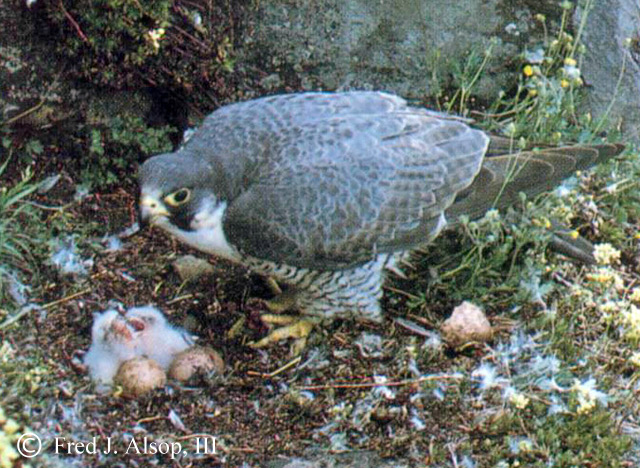The Peregrine Falcon is a fast and agile flyer; it can reach incredible speeds, particularly while diving. Most likely because of it flight capabilities, its territories tend to be larger than those of other raptors. Both sexes will defend their territory vigorously. The female is the dominant sex in this species; she usually eats first, and can be aggressive toward the male when he approaches the nest, even when he comes to feed her.
Length: 38.1 - 40.6 cm
Physical characteristics: This is a sleek, powerful falcon with long, pointed wings, a narrow, square tail, a strong, hooked beak and yellow legs and feet. It has a dark brown or black cap and a black stripe running down the side of the face. The upperparts are a bluish-gray. The throat and breast are white to buff, and the belly, thighs and sides are marked with dark barring. The sexes are similar in markings, but the female is larger.
Voice: Voice is a slow and rising series of rek, rek, rek.
Breeding habitat:
The Peregrine Falcon frequents open areas usually in close proximity to water, such as marshes, tundras, fields, swamps and tidal areas. It is increasingly being found in urban locales as well.
Mating system:
Monogamous; a Peregrine Falcon pair produces one brood per nesting season. Renesting is attempted in all but the northernmost portions of its range if a clutch is lost or destroyed.
Nest:
Preferred nesting sites include cliffs and bluffs, and in more recent times, tall buildings and towers, particularly if nesting boxes are provided. No nest is built. The female will typically scrape a hollow in the loose soil, sand or dead vegetation; occasionally grass is used as a lining.
Eggs:
The female lays 3 - 4 eggs. The eggs are cream, to buff, to a faint reddish color, with reddish-brown markings. 53mm (2.1'').
Chick development:
Incubation by both adults lasts from 29 to 32 days. The female does most of the incubation, however, while being fed by the male. The chicks are semialtricial when first hatched. The young fledge after 35 to 42 days in the nest, but are dependent on the parents for an additional two months.
Diet:
The diet of this raptor is made up almost exclusively of birds, from songbirds to waterfowl, although it will take a far lesser amount of small reptiles or mammals. The larger female often takes larger prey than her smaller mate. The peregrine hunts in the air with great speed, either snatching its prey in flight or clubbing it with its feet, thereby killing or disabling it and then retrieving it where it falls. The feathers are plucked from the prey before it is fed to the young.
Conservation Biology:
The Peregrine Falcon suffered dramatic population declines in the 1940?s through the 1970?s. The blame was put on several pesticides, which become more concentrated in the tissues of animals higher in the food chain, and either eventually killed the birds themselves, or weakened their eggshells and otherwise compromised their nesting success.
The banning of certain pesticides, along with a captive breeding and reintroduction program, has helped this species recover.
Special Protection Status:
Rangewide:
It was removed from the federal Endangered list in 1999.
Region:
On the North Carolina and Tennessee Natural Heritage Programs Lists of Rare Animals as "Endangered" (2001).
Breeding: The range of the Peregrine Falcon is almost worldwide. The only areas it is not found are Antarctica, New Zealand and Iceland. In the United States, this species is more common in the western states in the breeding season, and on the coastal areas and in Florida in the winter.
Winter: This bird is a neotropical migrant, wintering along the coast of the Gulf of Mexico and throughout Central America.
The Peregrine Falcon is an occasional year-round resident breeding bird species in the Park.
This species was extirpated in the Park, but 13 individuals were reintroduced in the mid 1980s. In recent years at least one pair is usually observed nesting in the Park each year. In a survey of breeding birds of breeding birds in the Park, performed from 1996-1999, Peregrine Falcons were observed in both 1998 and 1999. In 2003, two nesting pairs were observed.
References:
Alsop, F. J. III. 1991. Birds Of The Smokies. Great Smoky Mountains History Association, Gatlinburg, Tennessee.
Committee on Classification and Nomenclature of the American Ornithologists' Union. 2000. Forty-second supplement to the American Ornithologists' Union Check-list of North American Birds. The Auk 117: 847-858.
Committee on Classification and Nomenclature of the American Ornithologists' Union. 2002. Forty-third supplement to the American Ornithologists' Union Check-list of North American Birds. The Auk 119: 897-906.
Committee on Classification and Nomenclature of the American Ornithologists' Union. 1998. Check-list of North American Birds: the Species of Birds of North America from the Arctic through Panama, including the West Indies and Hawaiian Islands, 7th ed
Ehrlich, P. R., D. S. Dobkin, and D. Wheye. 1988. The Birder's Handbook: a Field Guide to the Natural History of North American Birds. Simon and Schuster, Inc., New York.
Elphick, C., J. B. Dunning, Jr., and D. A. Sibley, eds. 2001. The Sibley Guide to Bird Life and Behavior. Alfred A. Knopf, New York.
Gough, G. A., Sauer, J. R., Iliff, M. Patuxent Bird Identification Infocenter. 1998. Version 97.1. Patuxent Wildlife Research Center, Laurel, MD. http://www.mbr-pwrc.usgs.gov/id/framlst/infocenter.html.
Sibley, D. A. 2000. The Sibley Guide to Birds. Alfred A. Knopf, New York.
Stupka, A. 1963. Notes on the Birds of the Great Smoky Mountains National Park. University of Tennessee Press.
Animalia
Chordata
Aves
Falconiformes
Falconidae
Phenology
Tunstall

